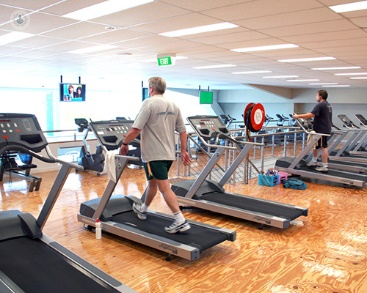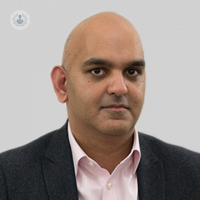How an implantable cardioverter defibrillator (ICD) could save your life
Escrito por:When your heart rhythm becomes too fast, you can be at risk of suffering a cardiac event. Luckily, there are small devices available that can be inserted into your chest to monitor and maintain a safe, normal heart rhythm. Dr Syed Ahsan explains these life-saving devices and the process involved in having one implanted.

An implantable cardioverter-defibrillator (ICD) is a cardiac device used to treat patients with heart rhythm abnormalities. The ICD is inserted underneath muscle on the left-hand side of the chest and is connected to one or two leads which lead into the heart via a vein at the top of your chest.
One of these leads goes into the bottom heart chamber (the ventricle) and, if required, the second lead goes to the top chamber (the atrium). This device constantly monitors your heart for potentially dangerous heart rhythms. If one is detected, the ICD sends a small electric shock to restore normal heart rhythm.
Are there different types of ICD?
There are two types of ICD:
- Transvenous ICD – this is inserted into the upper chest with leads running down the veins into the heart.
- Subcutaneous ICD – the device and the leads are inserted underneath the chest skin (i.e. there are no leads in the heart at all).
There are different benefits and risks of each type, which your cardiologist will inform you of when making your decision about which is best for you.
Why would you need an ICD?
There are a number of heart conditions that cause your heart to beat faster than is considered safe. Certain forms of heart failure can do e.g. when your heart does not pump effectively, as well as cardiomyopathies which are diseases of the heart muscle.
Dangerous heart rhythms tend to originate from the ventricles, which are the bottom heart chambers. These are known as ventricular fibrillation (VF) and ventricular tachycardia (VT). When your heart follows either of these of rhythms, it is pumping too quickly to fill properly, and hence the heart cannot pump blood effectively around the rest of the body.
Symptoms of these heart rhythms include
- palpitations
- feeling light-headed
- chest pain
In extreme cases, cases of VF and VT can cause you to lose consciousness or be fatal. This is why having an ICD can be life-saving.
How are ICDs implanted?
Insertion of an ICD will depend on which type you are having. It is a generally a straightforward procedure and can be done as a day case, meaning you can return home on the same day. It can be done with local anaesthetic and sedation, or with general anaesthetic.
Transvenous ICD
Once anaesthesia has been administered, a small incision is made in the upper chest and a small pocket is created underneath the skin for the battery or generator. The lead(s) are then passed through a chest vein which leads to the heart. The leads are positioned in the heart with one end being attached to the battery, which is either placed on top of or below the chest muscle. The incision is then closed with stitches.
Subcutaneous ICD (S-ICD)
This type is inserted with general anaesthesia and unlike the transvenous ICD, the lead from an S-ICD is placed under the skin in your chest, rather than inside the heart. The lead is connected to a battery which is buried on top of the chest muscle on the side of your chest. The incision is then closed with stitches. Before an S-ICD is placed, your suitability for this device will be determined with a thorough assessment by the specialist.
What happens after having your ICD implanted?
Some stitches will need to be removed after 7-10 days, depending on the type used by your cardiologist. Before being discharged from hospital, you will be given a card that explains your device to you and where it was inserted. You should carry this card with you at all times.
Are there any risks from this procedure?
The risks will depend on the type of device you are having implanted. These can include:
- Infection
- Bleeding and bruising
- Bleeding around the heart
- Scratching the surface of the lungs (pneumothorax)
- The risk of the leads moving
However, if any of these occur during surgery, they can all be treated and dealt with at the same time.
How long is the recovery from ICD implantation?
The wound from the incision takes a couple of weeks to heal. During the first week, the wound must be kept dry and clean to reduce the possibility of infection.
If you have had a transvenous ICD implanted, you should not lift your left arm (or right arm if it was inserted on the right side) above shoulder height for at least six weeks. This is important because the lead takes a while to ‘bed in’ and become fixed in place. Lifting your arm too soon can risk dislodging the ICD which could prevent it from working effectively. If this does happen, you may require a second procedure to reposition the lead and device.
What follow-up is required?
You will have a follow-up one month after having the ICD implanted. At this appointment, the device is checked to ensure it is working properly without any issues. Following this, you can expect to have it checked every six months to a year.
Your local cardiology team will give you the contact number for the device department. You can contact this team if you experience a shock from your ICD, or if there any other problems with the device. They will be able to check the device, if it has given you a shock, or if it working correctly.
Can you drive after having an ICD implanted?
You will not be able to drive for some time after having your ICD implanted, and you will need to inform the DVLA. How long you are not allowed to drive will depend on why the device was implanted in the first place.
How long does an ICD last?
The battery in the ICD can last for up to 10 years, after which it will have to be replaced. Again, replacing an ICD is a straightforward procedure and the leads can even remain in place, providing they are still working effectively. Most leads never need replacing and will last for the rest of your life.
Make an appointment with Syed Ahsan to discuss your treatment options and your suitability for ICD implantation.


